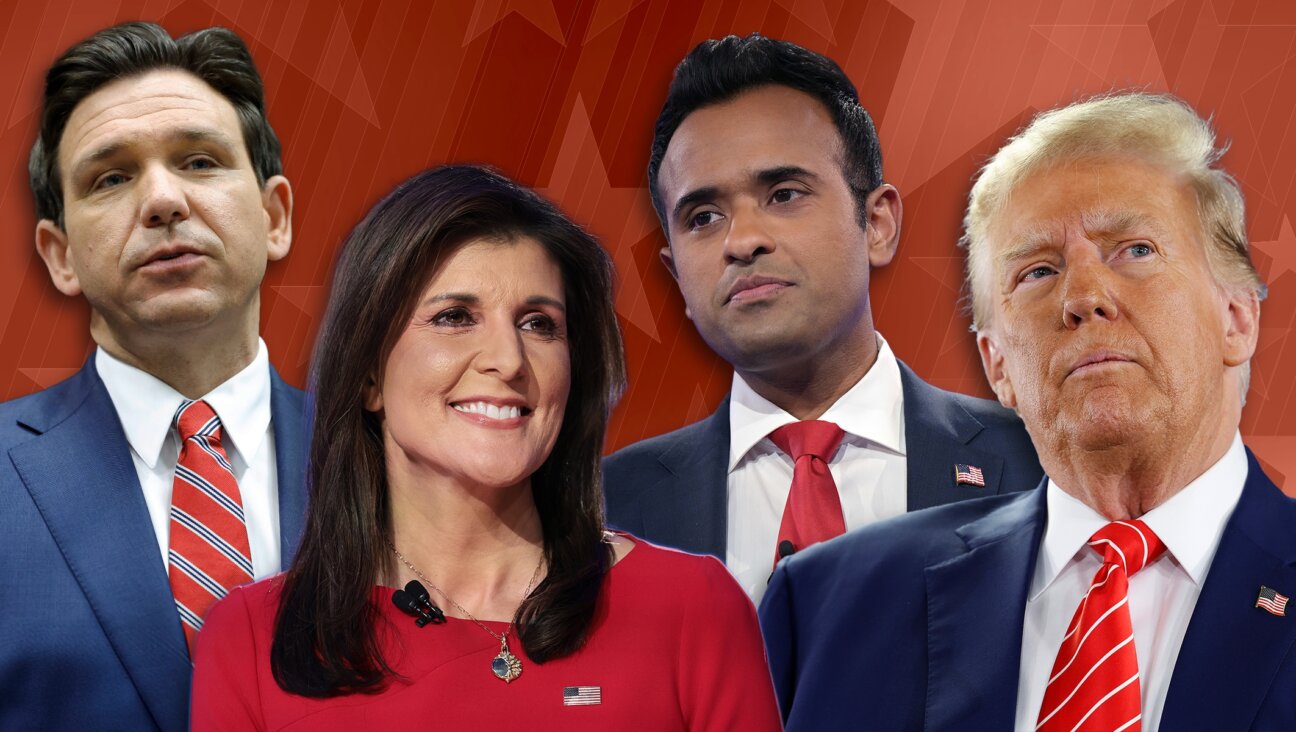Meet the LGBTQ couples whose queer-positive weddings measure up to Jewish legal standards
Pride meets the gatekeepers of Jewish law as observant couples reimagine gendered wedding rituals
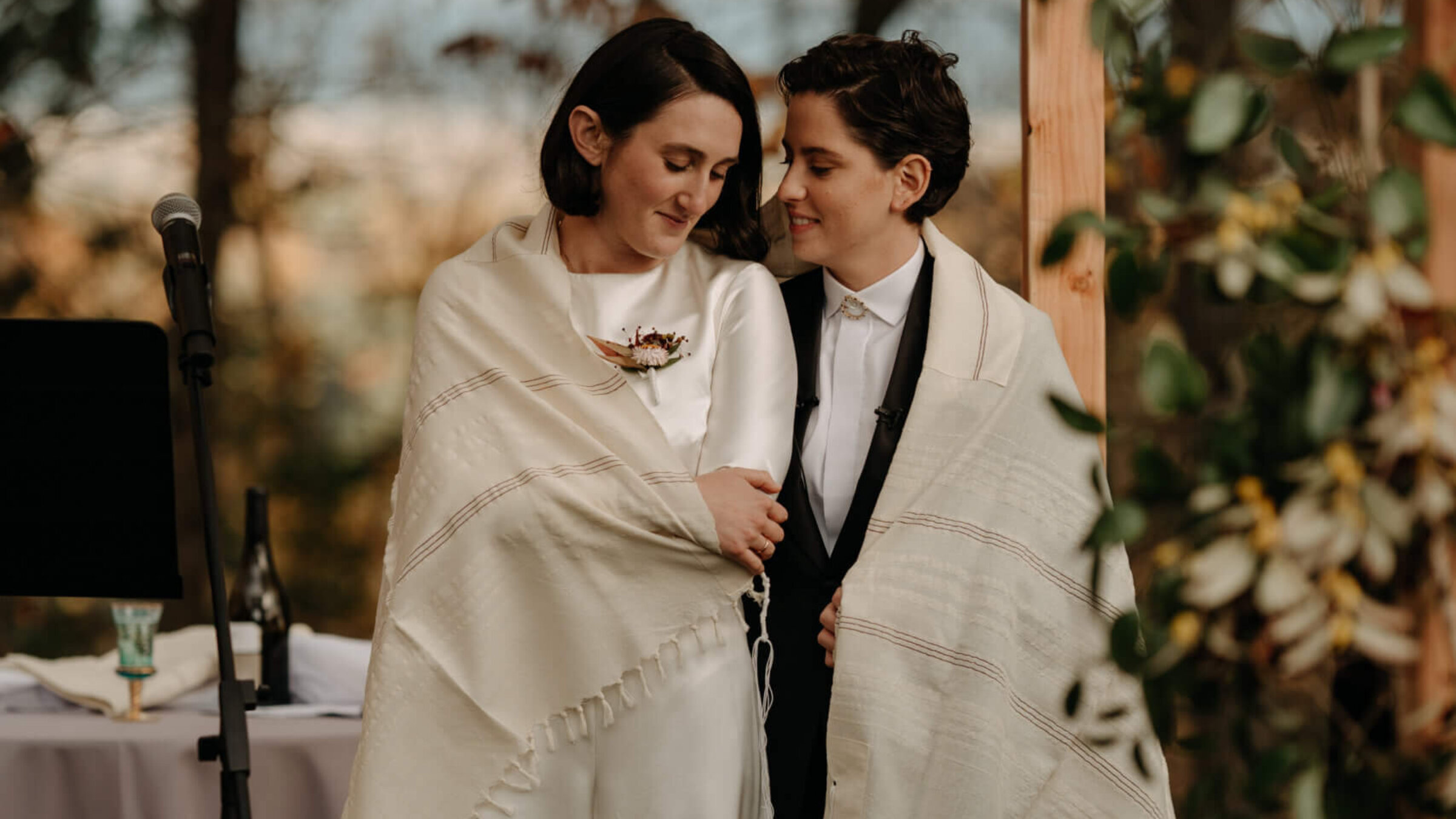
Tamar Lindenbaum, left, and Sabina Tilevitz pose for a wedding photo. Courtesy of Tamar Lindenbaum and Sabina Tilevitz
When Danya Lagos-Brown and Eliza Lagos-Brown got married in 2018, they knew they wanted a religious Jewish wedding. But instead of the standard ceremony, they crafted a personalized contract of obligations to one another, signed by witnesses, and recited their own Hebrew blessing under the huppah: “In acquisition of these rings, we are hereby partnered in the covenant of love as we agreed in the contract, according to the laws of Moses and Israel.” They then placed both rings in a bowl and lifted it up together.
It was almost like “starting a firm,” Lagos said, “rather than being purchased by one another.”
Overseen by Rabbis Aryeh Bernstein and Michael Schwab, the ceremony was based on a model first proposed by Rachel Adler, a Jewish feminist scholar who began researching legal alternatives to the Jewish ceremony of kiddushin in the 1980s. First used at a gay Jewish wedding in 1986, the brit ahuvim, or lover’s contract, incorporates the structure of a shtar shutafim, or business partnership. It’s a legal framework where the couple together acquires the relationship, rather than having one person acquire the other.
Kiddushin, the Jewish marriage ceremony that has been used for thousands of years, remains a stubbornly gendered ritual. It is the moment where the groom presents his bride with an object of value (usually an unadorned gold ring), and declares before two witnesses that with this ring, she is sanctified to him under the laws of Moses and the people of Israel. Once she accepts, the marriage is considered legal. He is obliged to care for her, and she is forbidden to have sexual relationships with other men. To dissolve the marriage, they would need a writ of divorce. While there are other rituals of legal significance for the Jewish wedding – the contract, the seven blessings, the moment of seclusion – this is when the couple becomes bound to one another under Jewish law.
It is a ritual both gendered and inescapably non-egalitarian, and one many queer Jews don’t consider legally reflective of their partnerships. But for queer Jews committed to halacha, or Jewish law, creating a ceremony outside the legal framework wouldn’t meet their religious needs, either. They want their wedding ritual to bind them together under Jewish law.
“When I’m fulfilling what I consider to be a mitzvah, I want to do it right, and have it be legally binding, or fulfill the requirements,” Lagos-Brown said. “We wanted a ceremony which was faithful to tradition and distinctly Jewish, and carried real legal weight. This was not just an expression of feeling, at one time, but a firm commitment for the future.”
Sam Greenberg, who grew up Orthodox and married Zach Cohen in 2017, agreed. He and his husband wanted a wedding that was innovative enough to reflect the reality of their partnership, but which shared a common vocabulary with the rituals that shaped the rest of their lives.

“We believe Jewish law obligates us to certain things,” said Greenberg. “We keep kosher, we keep Shabbat, and while we believe those things enrich our lives, we do them because we believe we are obligated. And if this is the way we walk through life, it would actually make less sense to say the most important piece of our lives is not going to be bound by that discourse at all.”
For their wedding, Greenberg and Cohen turned to Rabbi Steve Greenberg, the first openly gay Orthodox rabbi, to develop a ceremony which combined business partnership contracts with Jewish traditions of vow-taking and oaths to create a binding agreement of obligations under Jewish law.
Changing visibility for queer Jewish weddings
While queer Jewish weddings have been happening for years, they have only recently proliferated among Jews who, 10 or 20 years ago, might have felt there was no clear way for their marriages to be halachically valid and queer-positive.
The shift builds on decades of work by rabbis, scholars and others who have plumbed the vast canon of Jewish history and legal precedent to create ceremonies both unabashedly queer and firmly rooted in tradition. Most models today employ some version of vows, oaths, or partnership contracts, but there is no standard ceremony, and no two weddings are exactly alike. Once marginalized, the various proposals have caught increasingly mainstream interest.
“Prior to my own wedding, I had never been to a same-sex wedding of any kind,” Greenberg said, and neither had most of his guests. “But in the five years since we got married, we’ve been to half a dozen other weddings that were like ours.”
Idit Klein, who leads Keshet, an organization that works for full LGBTQ inclusion in Jewish life, described the rise as more about shifts in perception than anything else. “There is a public visibility that did not exist until recently,” she said.
For example, Jewish queer weddings are now being publicized in synagogue bulletins, in alumni newsletters from Jewish day schools, and even in wedding announcements in The New York Times. That wasn’t happening a few years ago, and it’s still not happening in most of the Orthodox world.
“This is something that queer Jews have always done, but what has changed is the number of rabbis who are willing to officiate at queer weddings, who are willing and happy to engage in the process of co-creating ceremonies, and the number of synagogues where people can get married in sanctuaries,” Klein said.
For LGBTQ Jews who feel bound by halacha, the ability to be married in a Jewish ceremony which works within Jewish law, not around it, is a significant development.
Rabbi Dena Bodian, who wrote her rabbinical school thesis on halachic partnerships between same-sex couples, says that most people she knew when she married her wife in 2009 believed weddings could be queer or Jewish, but not both.
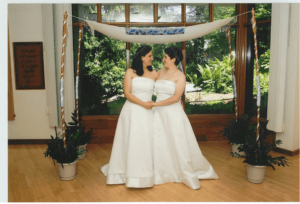
“There were not that many halachically committed gay Jews out there who were trying to get married within the purview of halacha, and really took it seriously,” she said. She believes such attitudes began to change “around the same time that, in secular America, people stopped having commitment ceremonies and started having weddings.”
Bodian received ordination in 2010 from Hebrew Seminary, a rabbinic school for the deaf and hearing in Chicago, though she was a visiting student at the Jewish Theological Seminary in 2008, the first year they accepted LGBTQ rabbinic students. She believes greater exposure to observant queer Jews helped speed halachic changes. For her wedding, she developed a double-column reciprocal ketubah, which she sees as more traditional than other models.
“People started to really recognize that it was possible to be deeply committed Jews and have a richly Jewish home and want to take Jewish law very seriously, and also be married to someone of the same sex.”
Rethinking a wedding’s defining moments
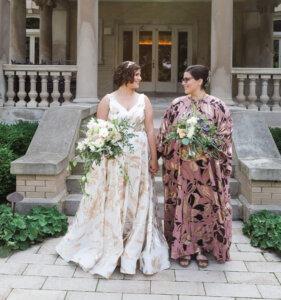
Though options abound, queer Jews looking to marry within Jewish law and tradition still have much to consider. Even in movements that have embraced queer Jewish weddings, there are many synagogues that either do not allow same-sex weddings, or relegate them to a space outside the main sanctuary. The Lagos-Browns, for example, together with a parent-support group based at the synagogue, had to lobby the Conservative synagogue in Chicago where they married to first change its policy on same-sex weddings, a communal process which paved the way for subsequent queer celebrations.
It can also be hard to find the right officiant, and even harder to navigate the variety of options available, both for the ceremony itself and the surrounding rituals.
The traditional Jewish wedding, after all, is not just the ceremony: There is the stomp at the end, where the groom smashes a glass with his foot — to remember, even in this joyful moment, that we live in a broken, unredeemed world — and the crowd bursts into cries of congratulations. There is the bedeken, where the groom is raucously danced into the bride’s reception for her veiling ritual, and the two behold one another for the first time that day. There are the seven circles the bride walks around the groom, the moment of seclusion guarded by friends, the chosen witnesses, the biblical verses turned into song, the dancing and the shtick. Customs might differ by community and culture (some rooted in actual Jewish law, some in social convention, and many observed today only by a subset of Jews). But to anyone accustomed to its rhythms, the traditional Jewish wedding holds any number of defining moments, nearly all of them gender-specific.
Couples who want their wedding to be both queer and traditional are often starting from scratch, which can be daunting.
“Every queer Jewish source that I read, there was no mention of what you should do instead of a bedeken,” said Tamar Lindenbaum, who married Sabina Tilevitz in 2021. (The author of this article attended the wedding.) Both grew up in modern Orthodox Jewish communities. “But what is the bedeken? It is the moment when everybody watches the bride and groom together for the first time. I wanted something that mimicked that, and where everyone who had come to celebrate our wedding would come together and see us see each other and sing and dance together. So for us, it was about finding those cultural touchstones.”
That also meant rethinking the values behind the traditions. For Lindenbaum, one way to “meld tradition with egalitarianism” was to think not about “what men do or what women do” at a Jewish wedding, but “what people do.” And so, both she and Tilevitz wore a kittel, a white robe traditionally donned by grooms to symbolize solemnity and spiritual elevation, and circled one another. They also chose to enter the huppah together, rather than have one person bring the other in. It was a ceremony crafted from a myriad of sources, based on countless hours of research and discussion, in addition to input from scholars and rabbis and learned friends within their networks.
But not every couple has the time, Jewish education, community resources or even inclination to reimagine their wedding. “There’s no standard script out there for a same-sex Jewish wedding,” said Daniel Olson, director of strategy and research at Camp Ramah, who married Rabbi Ben Goldberg in 2018. “The huppah and the circling and saying blessings and signing a document and drinking wine and smashing the glass was definitely there for us to draw on, and that was great, but when we got into the nitty-gritty of the ceremony, we couldn’t follow the standard scripts and had to come up with something ourselves.”
While Olson cherishes the time he and Goldberg spent before their wedding poring over Jewish law and considering exactly what words and blessings would best capture their relationship, he knows that’s not realistic — or even desirable — for everybody.
“One thing that my husband always says is that you buy inclusivity at the expense of uniformity,” Olson said. “One of the powerful aspects of ritual is that you don’t have to think about it, because it has been time-tested for many years and it’s there for you at that moment in your life when you need it. And in terms of the exact scripts of same-sex Jewish weddings, we’re not quite there yet.”
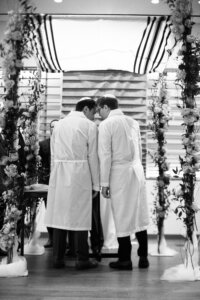
Legal alternatives to kiddushin
Rachel Adler began looking into legal alternatives to kiddushin after her divorce in 1981. She was horrified by the lack of female agency in Jewish marriage and divorce law, and wanted to find something a little more equal. Her research was inspired by the groundbreaking work of her teacher, Orthodox Rabbi Eliezer Berkovits. He wrote one of the first modern legal works arguing that tenaim, the legal categories undergirding conditional marriages and divorces discussed in the Talmud, could be revived to make modern Jewish weddings more egalitarian. She was also moved by the wedding contracts from late antique Palestine that were discovered in the Cairo Genizah, which included negotiations about what both the groom and the bride were entitled to do.
“Something about having the voices of both the participants, and having a document that’s made to negotiate what each of them needs or hopes for in the relationship, that spoke to me,” Adler said. “And I wanted to make a document that would do that.”
Adler included the contract for her brit ahuvim in her 1988 book “Engendering Judaism.” It became a go-to template for Jewish couples looking for legal alternatives to kiddushin. In 2012, the legal body of the Conservative movement issued teshuvot (rulings) on alternatives to kiddushin for queer couples, including the brit ahuvim. The rulings built on the 2006 call from Conservative Judaism for recognition of such unions within Jewish law, a position still rejected by Orthodox Judaism.
Adler’s contract replaces the man’s acquisition of his wife with conditions and obligations mutually agreed upon by the couple. “In the brit ahuvim, what you’re acquiring is the relationship itself,” Adler said. She also includes provisions for dissolution of the agreement. But there is no set text. Ultimately couples decide for themselves what their commitments might include, from regulations around physical intimacy to end-of-life care.
It is an approach which has opened up conversations about the meaning of a Jewish wedding, and the dexterity of the tradition to meet new needs with ancient resources.
When Olson and Goldberg were planning their wedding, for example, they took Adler’s recommendation to substitute the traditional erusin blessing with the blessing of a rainbow from the Book of Genesis. “It captured that feeling of covenants, and agreements and responsibilities, the sort of a weightiness of the promise that you make in marriage to one another,” Olson said. “But then also, of course, the rainbow is one of the key symbols of LGBTQ pride. And our wedding was actually the 40th anniversary of the Pride parade in San Francisco, when Gilbert Baker’s rainbow pride flag debuted.”
They also substituted the terms ahuv and rayah, meaning lover and friend, for chatan and chatan, or groom and groom. The words ahuv and rayah are “already native to other parts of these seven blessings,” Olson said. “And the ability to feel seen in the tradition as already written seemed like an opportunity to take advantage of, rather than doing what is perhaps a more blunt change.” Though Hebrew is a gendered language, those words are also “a little more gender-neutral,” and therefore potentially appropriate for nonbinary individuals.
Miryam Kabakov, who directs Eshel, an organization for LGBTQ Orthodox Jews, noted that some couples can have emotional or even conflicting feelings about recreating the rituals of straight weddings, which they might associate with inequality or exclusion.
“Some people want their ceremony to have the same liturgy and cadence, to have the same rhythm and the rituals of a straight wedding. And then, some couples want it to look completely not like that, and be its own thing,” she said.
Bodian and her wife, for example, chose to keep the Hebrew language of “bride and groom” for their ceremony, seeing it as a general term for the archetypal Jewish couple, with a meaning that was not inherently gendered.
Tilevitz found herself initially unsure what she wanted.
“A lot of the time I was sitting in straight Jewish weddings, feeling ‘this is not in my future, this is not what my wedding is going to look like,’” she said. “And so much of the feeling of ‘my wedding is never going to look this way’ was not from a distaste for what those weddings look like, but a feeling of deep rejection and shame.”
Eventually, Tilevitz realized publicly celebrating her love for Lindenbaum in a traditional wedding where she could dress as she wanted and feel seen within these rituals was something she wanted not just for herself now, but for her teenage self, and for every other Jewish kid out there unsure if such a wedding could be in their future.
An LGBTQ wedding, but ‘really Jewish’
“A lot of people said to us that our wedding allowed them to imagine their wedding, which was kind of our goal,” Lindenbaum said. “The idea that we were going to celebrate, and we were going to be really Jewish, and my frum parents from Teaneck, and my grandparents, can walk down the aisle to my huppah, at my wedding, was another step forward.” Maybe someday, she mused, the Orthodox Jewish day school she attended will change its policy and include LGBTQ weddings in the alumni announcements.
But what most moved Lindenbaum was what their wedding meant to her own family, who are now very supportive but struggled to welcome Tilevitz during the first few years of their relationship.
“My biggest fear was that my parents would go into shul and people would say, ‘oh, they’re the parents of that gay girl,’” Lindenbaum said “And that is exactly what happened, but my parents were so proud of it. They called me every day after our wedding to talk about how people kept calling them to say they had not expected the wedding to feel so Jewish.”
They’re among many gay Jewish couples rooted in traditional observance who see their weddings as not just personal celebrations, but public examples of what’s possible in the observant community more broadly.
“Things become established and become authentic over generations, when there is a well of past experience in history to draw on,” said Greenberg. “I think what’s really empowering and exciting is that we’re in the middle of creating that history, of creating that well of shared experiences.”
For Lindenbaum, it was important that the kinyan and tenaim — the method of acquisition and the conditions underlying their partnership — had binding, legal Jewish standing, both for herself and for her guests. “I wanted this feeling of familiarity for people to whom gay love is unfamiliar,” Lindenbaum said. “I wanted other people who came to the wedding to feel that this was a frum wedding. It was really important to me that it wouldn’t be like we were playing pretend. For guests who had never been to a wedding like this, I wanted them to feel like the wedding was real and that we weren’t just misappropriating Jewish sources, even if they disagreed halachically with what we were doing.”
Kabakov, at Eshel, said uniformity around marriage rituals will help legitimize them for Orthodox rabbis who are being asked to conduct such ceremonies, but don’t know how to evaluate their unprecedented legal structures.
“I’m sure there will still be a lot of creativity, but it would mean Orthodox rabbis asked to do such ceremonies would have a structure that they can stand behind and where they can tell couples the options and, of course, have a standard mechanism by which the couples can release one another if they decide to break up,” she said.
Such a process has already begun in the Conservative Jewish world, and the impact remains to be seen.
Adler is moved to see how widely her own ritual has spread, but she’s also excited for more options to arise. “This is one way of solving the problem,” she said. “It’s not in any way the only way of solving the problem. And if any people, LGBTQ people or any people, think that there’s a better legal way, good for them. I’m just saying that if you just have a lot of fuzzy sentiments, and you know, little quotations from Shir Hashirim (Song of Songs), you don’t have the kind of solid substance about spelling out the commitment that you have when you use law.”
The Forward is free to read, but it isn’t free to produce

I hope you appreciated this article. Before you go, I’d like to ask you to please support the Forward.
Now more than ever, American Jews need independent news they can trust, with reporting driven by truth, not ideology. We serve you, not any ideological agenda.
At a time when other newsrooms are closing or cutting back, the Forward has removed its paywall and invested additional resources to report on the ground from Israel and around the U.S. on the impact of the war, rising antisemitism and polarized discourse.
This is a great time to support independent Jewish journalism you rely on. Make a gift today!
— Rachel Fishman Feddersen, Publisher and CEO
Support our mission to tell the Jewish story fully and fairly.
Most Popular
- 1

Fast Forward Ye debuts ‘Heil Hitler’ music video that includes a sample of a Hitler speech
- 2

Opinion It looks like Israel totally underestimated Trump
- 3

Culture Cardinals are Catholic, not Jewish — so why do they all wear yarmulkes?
- 4

Fast Forward Student suspended for ‘F— the Jews’ video defends himself on antisemitic podcast
In Case You Missed It
-

Opinion It looks like Israel totally underestimated Trump
-
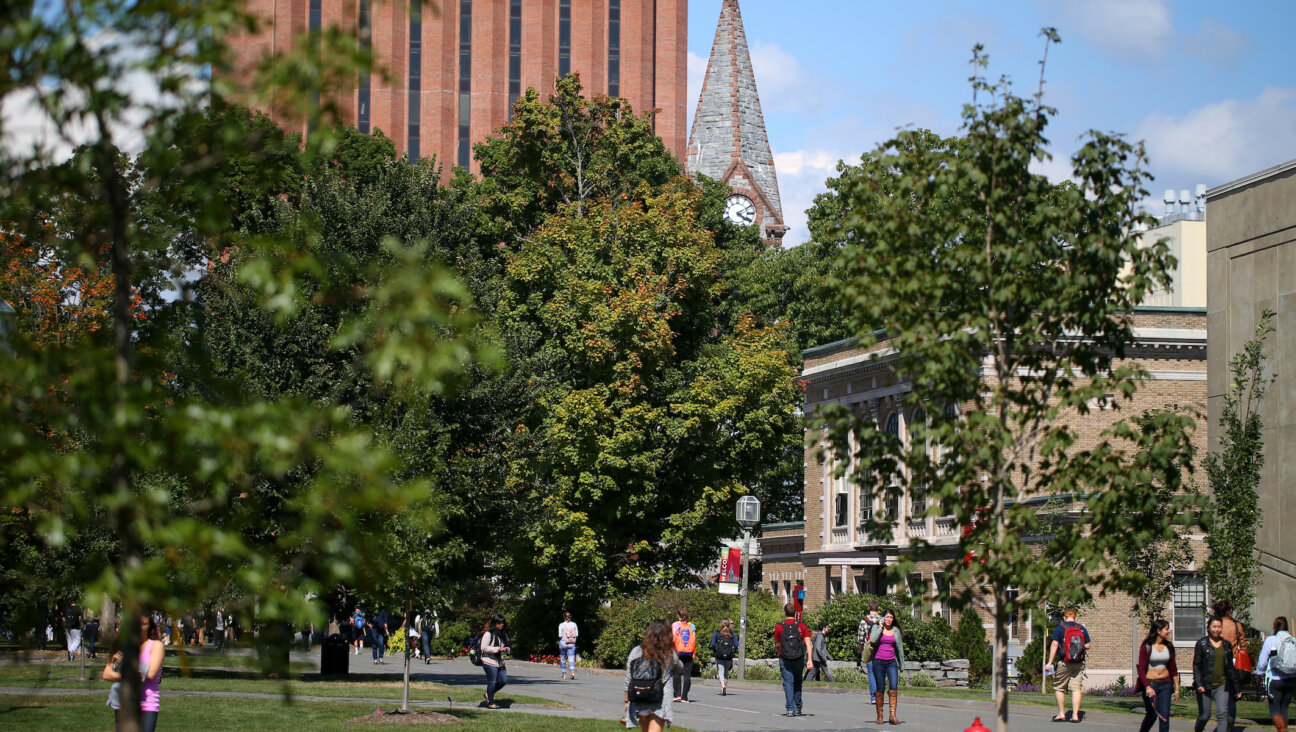
Fast Forward Betar ‘almost exclusively triggered’ UMass student detention, judge says
-

Fast Forward ‘Honey, he’s had enough of you’: Trump’s Middle East moves increasingly appear to sideline Israel
-
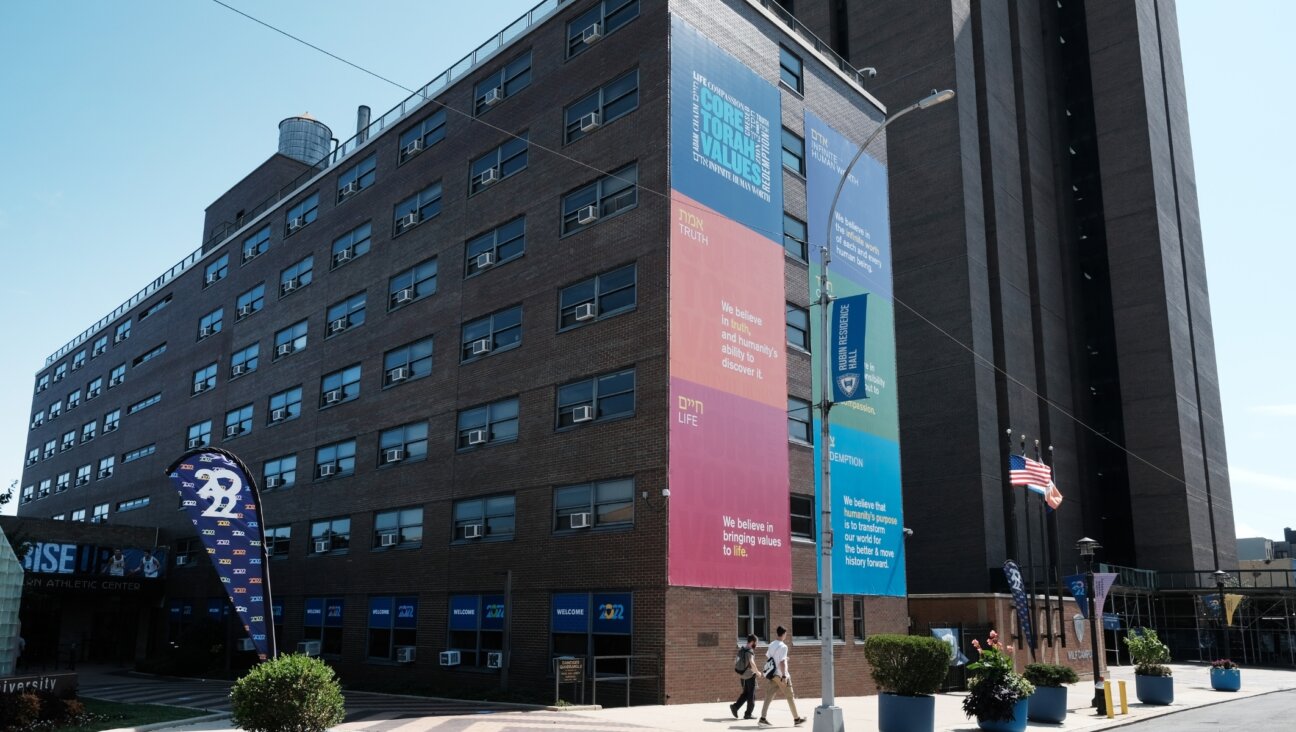
Fast Forward Yeshiva University rescinds approval for LGBTQ+ student club
-
Shop the Forward Store
100% of profits support our journalism
Republish This Story
Please read before republishing
We’re happy to make this story available to republish for free, unless it originated with JTA, Haaretz or another publication (as indicated on the article) and as long as you follow our guidelines.
You must comply with the following:
- Credit the Forward
- Retain our pixel
- Preserve our canonical link in Google search
- Add a noindex tag in Google search
See our full guidelines for more information, and this guide for detail about canonical URLs.
To republish, copy the HTML by clicking on the yellow button to the right; it includes our tracking pixel, all paragraph styles and hyperlinks, the author byline and credit to the Forward. It does not include images; to avoid copyright violations, you must add them manually, following our guidelines. Please email us at [email protected], subject line “republish,” with any questions or to let us know what stories you’re picking up.









